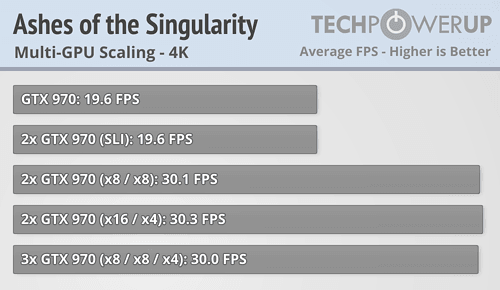 78
78
Ashes of the Singularity DirectX 12 Mixed GPU Performance
Conclusion »Test System
| Test System - VGA Rev. 41 | |
|---|---|
| Processor: | Intel Core i7-6700K @ 4.5 GHz (Skylake, 8192 KB Cache) |
| Motherboard: | ASUS Maximus VIII Hero Intel Z170 |
| Memory: | G.SKILL 16 GB Trident-Z DDR4 @ 3000 MHz 15-16-16-35 |
| Storage: | WD Caviar Blue WD10EZEX 1 TB |
| Power Supply: | Antec HCP-1200 1200W |
| Cooler: | Cryorig R1 Universal 2x 140 mm fan |
| Software: | Windows 10 64-bit |
| Drivers: | NVIDIA: 361.91 WHQL AMD: Catalyst 15.301-B35 Feb 10 Press Beta |
| Display: | Acer CB240HYKbmjdpr 24" 3840x2160 |
Mixed GPU Performance


In the first (blue) section of these charts, we established baseline values for single-GPU performance. Here, we can clearly see the large performance advantage AMD currently has over NVIDIA when it comes to DirectX 12 in Ashes of the Singularity. A R9 390X, for example, roughly matches the GTX 980 Ti, a card that's usually over 20% faster than the R9 390X.
Another interesting data point is the GTX 780 Ti as it is usually roughly on par with the GTX 970. In Ashes, it is slightly faster than the GTX 970 at 1080p, but falls far behind it once we crank the resolution up to 4K. By the way, all our benches and the video were done at the highest setting called "Crazy".
Let's now look at mixing different GPUs. The first takeaway here is that the slowest card will play a huge role in determining the final performance result. A GTX 980 Ti paired with a R9 380, for example, doesn't even get close to GTX 970 single-GPU performance. When looking at the original R9 380 numbers, though, we see a 78% performance uplift. In conclusion, you'll ideally want to pair cards of similar performance with each other to maximize your setup's price-to-performance ratio.
Another interesting effect becomes apparent when looking at identical combinations, just by swapping the first and second GPU around. The first GPU is always the one the monitor is connected to. Here, we see that using the faster GPU, which is the Fury X, as the primary card results in better overall performance. Looking at the Fury X+GTX 980 Ti, just swapping your monitor's cable around can provide a 5% performance uplift.
Multi-GPU Scaling

Finally, we also wanted to look at multi-GPU scaling with identical GPUs. We picked the GTX 970 for these tests because it is extremely popular and I have three of them.
With NVIDIA SLI enabled, we see no scaling at all, which is because there is no SLI profile for the game yet. This also serves as proof that there isn't any SLI happening in the background. Ashes of the Singularity clearly controls what is rendered on which GPU and at what time separately. The next result with both cards running in our Z97 motherboard's electrical x16 slots, a typical SLI configuration, shows 54% scaling, which is decent, but lower than with a traditional SLI setup in other games. Next, I expected a performance drop with the second card running in the third PCIe slot, which is only x4 and is routed through the chipset at slower speeds. The result is surprising, though, as performance is actually slightly better, definitely not reduced. My best guess is that giving the first card full x16 access slightly boosts its performance, while the performance loss of x4 is negligible, which makes combined performance a little better. I do doubt, though, that this is a practical configuration, although it does make for an interesting result.
I also wanted to test triple-GPU scaling, which apparently is not supported by Ashes of the Singularity. If you think about it, splitting a frame into three pieces and stitching it together after rendering it is significantly more complex from a developer's perspective.
May 13th, 2024 15:18 EDT
change timezone
Latest GPU Drivers
New Forum Posts
- PKG Power much higher than usual (8)
- Which Audio System Would you Choose and Why? (18)
- Which RAM for AMD 7950X3D (6)
- Purchased an AX1200i PSU as part of some forward planning, what tier is this PSU? (85)
- 2024 and STILL no dark mode? (43)
- Results and questions (6)
- Dell Workstation Owners Club (3083)
- How to optimize my PC by overclocking my system (16)
- What's the best tube I can get for Schiit Vali 3 headphone amp under $30? (5)
- TPU's Rosetta Milestones and Daily Pie Thread (1880)
Popular Reviews
- ZMF Caldera Closed Planar Magnetic Headphones Review
- Homeworld 3 Performance Benchmark Review - 35 GPUs Tested
- Corsair MP700 Pro SE 4 TB Review
- Bykski CPU-XPR-C-I CPU Water Block Review - Amazing Value!
- ThundeRobot ML903 NearLink Review
- Upcoming Hardware Launches 2023 (Updated Feb 2024)
- AMD Ryzen 7 7800X3D Review - The Best Gaming CPU
- CHERRY XTRFY M64 Pro Review
- ASUS Radeon RX 7900 GRE TUF OC Review
- Corsair iCUE Link RX120 RGB 120 mm Fan Review
Controversial News Posts
- Intel Statement on Stability Issues: "Motherboard Makers to Blame" (266)
- AMD to Redesign Ray Tracing Hardware on RDNA 4 (224)
- Windows 11 Now Officially Adware as Microsoft Embeds Ads in the Start Menu (172)
- NVIDIA to Only Launch the Flagship GeForce RTX 5090 in 2024, Rest of the Series in 2025 (152)
- Sony PlayStation 5 Pro Specifications Confirmed, Console Arrives Before Holidays (119)
- AMD Hits Highest-Ever x86 CPU Market Share in Q1 2024 Across Desktop and Server (114)
- AMD's RDNA 4 GPUs Could Stick with 18 Gbps GDDR6 Memory (114)
- AMD Ryzen 9 7900X3D Now at a Mouth-watering $329 (104)